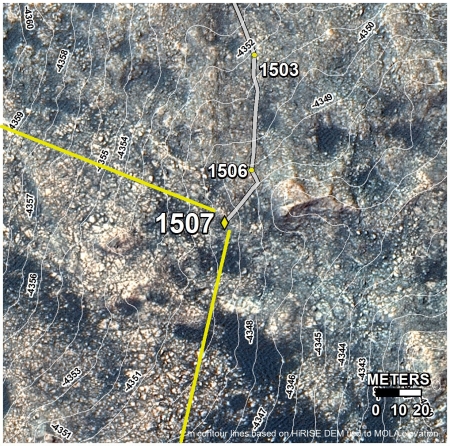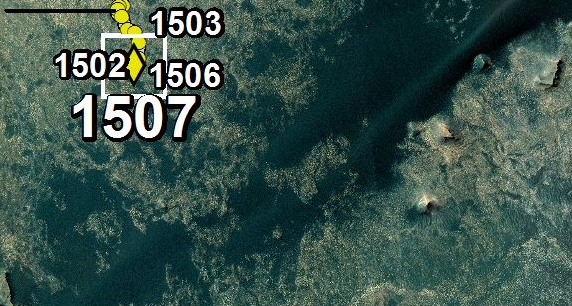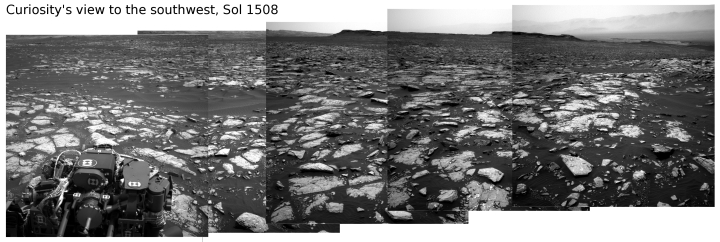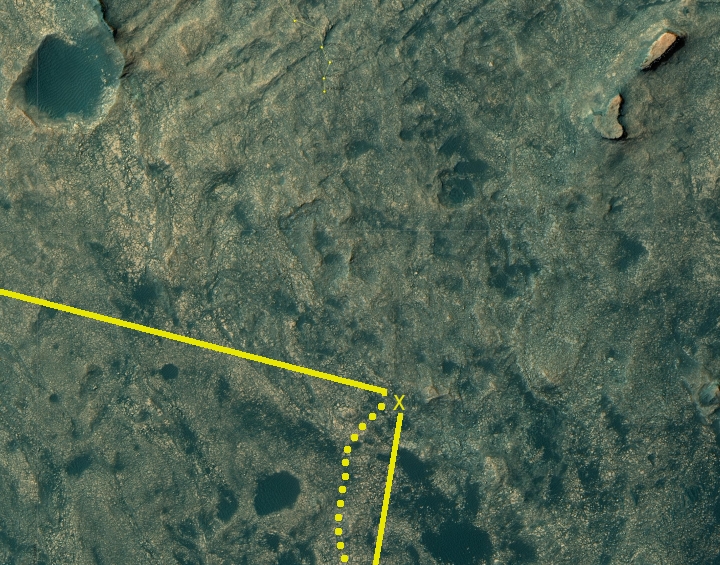Mars rover update: November 3, 2016
Curiosity
Post updated: See last paragraph in Curiosity section.

For the overall context of Curiosity’s travels, see Pinpointing Curiosity’s location in Gale Crater.
After spending almost a month on the flats south of Murray Buttes, during which the rover drilled another hole, in the past week Curiosity has finally resumed its journey south toward the slopes of Mount Sharp and the sand dune area that it must cross to get there.
Unfortunately, NASA has decided to change how it shows the rover’s progress, and these changes seem to me to be a clever and careful effort to make it more difficult for the public to make educated guesses about where the rover might be heading in the very near future. The image to the right is the cropped inset showing the rover’s recent travels that is part of a new a larger image that puts this inset in the context of the rover’s entire journey. This has replaced the wider orbital mosaic that they used to provide (see for example my September 27, 2016 rover update) that gave a very good view of the entire terrain surrounding the rover from which a reasonable estimate of its future path could be guessed.

The new image not only doesn’t show much of the nearby geography, in the overall view the placement of text makes it impossible to get a clear view of the upcoming terrain. To the left is the specific section of this newly redesigned Curiosity location image that shows the rover’s position on the edge of this dune area. Unfortunately, the yellow diamond and the large “1507” text block a clear view of the sandy areas directly in front of the rover.
Nonetheless, from what I can gather the rover has now moved far enough south to reach the edge of the sand dune area that it must cross to reach Mount Sharp. Recent images have shown an increasing amount of dark sand covering the ground’s patchwork of flat rocks. The panorama below, created by me from images taken by the rover’s left navigation camera on Sol 1508 and whose view is indicated in the overhead view above, shows these sandy patches. In fact, as the science team noted in its Sol 1508 update), “Because only a few rocks are exposed in the arm workspace, the tactical team decided against contact science in favor of maximizing the drive distance on Sol 1508.”

Rather than study the rocks around them, they are going to focus their efforts in the coming days in plotting out the safest route through this sandy area. The direction of the panorama once again suggests to me that they will head to the southwest so that they can cut through the most obvious gap in the dunes, as shown in the overhead view.
Below is the last orbital view using the wider mosaic that showed far better the context of Curiosity’s travels. I have annotated it to show where the rover is now, and have indicated where I think it will be heading next.

Update: I have no idea if my comments above had any influence, or if they were merely planning to switch back, but the Curiosity team that posts updates on the rover’s location today, November 3, 2016, abandoned the terribly uninformative orbital image I complained about above and went back to the earlier wider orbital images that show much more of the geography surrounding the rover. For this I am very grateful.
Opportunity
For the overall context of Opportunity’s travels at Endeavour Crater, see Opportunity’s future travels on Mars.
Since my October 6, 2016 update, Opportunity has remained in the same spot, on top of Spirit Mound, during which they have taken a lot of pictures of this mound and its surface rocks, as well as the surrounding terrain.
They are planning to back off the mound today, and will head south working their way inside the crater’s rim until they get to gully they intend to use to drop into the floor of Endeavour Crater.
On Christmas Eve 1968 three Americans became the first humans to visit another world. What they did to celebrate was unexpected and profound, and will be remembered throughout all human history. Genesis: the Story of Apollo 8, Robert Zimmerman's classic history of humanity's first journey to another world, tells that story, and it is now available as both an ebook and an audiobook, both with a foreword by Valerie Anders and a new introduction by Robert Zimmerman.
The print edition can be purchased at Amazon or from any other book seller. If you want an autographed copy the price is $60 for the hardback and $45 for the paperback, plus $8 shipping for each. Go here for purchasing details. The ebook is available everywhere for $5.99 (before discount) at amazon, or direct from my ebook publisher, ebookit. If you buy it from ebookit you don't support the big tech companies and the author gets a bigger cut much sooner.
The audiobook is also available at all these vendors, and is also free with a 30-day trial membership to Audible.
"Not simply about one mission, [Genesis] is also the history of America's quest for the moon... Zimmerman has done a masterful job of tying disparate events together into a solid account of one of America's greatest human triumphs."--San Antonio Express-News


Yeah that newest Curiosity map looks like it was done by a kid. Very unprofessional.